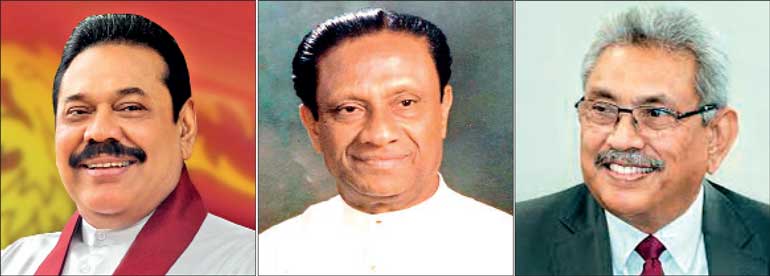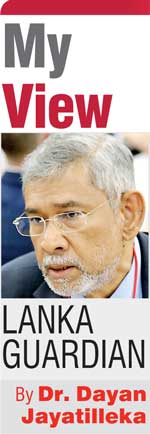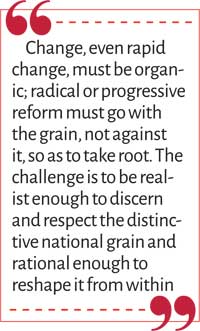
President Gotabaya Rajapaksa’s elder brother Mahinda had, like Premadasa before him, “the sense of reality”; a sensitive feel of the grain, and a grasp of the long continuum of Lankan politics. GR’s own military and Alt-Right formation has not provided him that sense and sensibility
 Writing by invitation in a column reserved in The Economist for ‘Global Thinkers’ (Francis Fukuyama is one such), Dr. Henry Kissinger, at 98 still the finest mind on international relations and world politics, makes several fundamental observations on the Afghanistan outcome (also quoting himself in a 2010 article to underscore that he isn’t being wise after the event).
Writing by invitation in a column reserved in The Economist for ‘Global Thinkers’ (Francis Fukuyama is one such), Dr. Henry Kissinger, at 98 still the finest mind on international relations and world politics, makes several fundamental observations on the Afghanistan outcome (also quoting himself in a 2010 article to underscore that he isn’t being wise after the event).
Firstly, the underlying tribe and clan-based composition and character of Afghanistan makes it impossible to sustain a modern, centralised, democratic state. Secondly, these centrifugal factors notwithstanding, a centripetal dynamic is unleashed and most clans converge to fight against and oust any outsider (the invading British force in the 19th century had only a single survivor who made it across the border).
Thirdly, the over-ambitious agenda that the USA had mistakenly arrived at, could not be sustained by America’s domestic political dynamics and political cycle. Fourthly, the US withdrawal and post-withdrawal scenario should and could have been negotiated with fellow stakeholders Russia, China, India and Pakistan, but wasn’t. (Henry Kissinger on why America failed in Afghanistan | The Economist – https://www.economist.com/by-invitation/2021/08/25/henry-kissinger-on-why-america-failed-in-afghanistan)
The relevance to Sri Lanka of Dr. Kissinger’s essay is that the fundamental structures and dynamics of a society, as evident in long-term trends and recurrent phenomena, determine the country’s continuum of consciousness and parameters of political outcomes, and no idealistic or external schema can be imposed upon it without disaster consuming the political class, state and system.
The sense of reality
Change, even rapid change, must be organic; radical or progressive reform must go with the grain, not against it, so as to take root. The challenge is to be realist enough to discern and respect the distinctive national grain and rational enough to reshape it from within.
Perhaps the finest liberal thinker of the 20th century, Sir Isaiah Berlin famously demonstrated (it is the title of one of his books), that what separates a great and successful politician from others of his/her profession, is the possession of an inestimably valuable quality: ‘The Sense of Reality’.
President Gotabaya Rajapaksa’s elder brother Mahinda had, like Premadasa before him, “the sense of reality”; a sensitive feel of the grain, and a grasp of the long continuum of Lankan politics. GR’s own military and Alt-Right formation has not provided him that sense and sensibility.
- Sri Lanka is the oldest democracy in Asia and indeed in Afro-Asia.
- Sri Lanka is a vibrant, hyper-political, civilian democracy.
- Sri Lankans, especially the majority community/ the ‘greater South’, always resisted totalitarianism and hard authoritarianism, from right and left, above and below. The Sinhalese have a democratic ethos and vocation. The JVP couldn’t do in the South, what the LTTE did in the North. The LTTE retained their totalitarian control with sufficient popular consent even against the Indian Peace-keeping Forces. Despite civil wars, there was never a military takeover in Sri Lanka, unlike in many countries of the global South and East Asia. Nobody in the island’s South has any romantic nostalgia about the days the “punchi aanduwa” (“little government” i.e., the insurrectional JVP) rather than the state, literally called the shots. There is nostalgia in the North and the Tamil Diaspora about the LTTE.
- Sri Lankans are opinionated; they are individualist; they value their individuality and individual rights, especially that of free expression. That free expression usually includes humour and biting political satire.
- The Sri Lankan citizenry is accustomed to a standard of living ensured by (a) social welfare and (b) the consumerism of the open economy (since 1977). It is acutely allergic to austerity and scarcities. If a ruler and ruling party impose painful ‘sacrifices’ on it materially, it will ‘sacrifice’ that ruler and party several times, over a longer period.
- The centre of gravity of Sri Lanka cannot be a foreign-owned and controlled artificial island which houses foreign capital, financial services and IT; the centre of gravity is the rural heartland. The foundation of the island’s historically evolved Social Contract is between the state and the Sinhala peasantry.
- Barring a few clusters or thin sub-stratum, the Sri Lankan elite, and the upper-middle classes, including the bulk of the officer corps of the military, will always be more West-centric than Sino-centric, for reasons of language (English), relatives in the diaspora, the education of children, etc.
The fertiliser-weedicide-pesticide ban and the Parakrama Samudraya walking-path are disaggregating the triangle of ruler-peasantry-heritage.
TNA and 13A
The Tamil political formations should nurture ‘the sense of reality’.
- On this small, civilisationally and demographically distinctive island neighbouring Tamil Nadu, the overwhelming majority of Sri Lankans will not agree to federalism or deleting the de jure unitary status.
- War for Tamil Eelam ended in devastating defeat. Post-1987 demands, projects and negotiations going beyond 13A in a federal direction repeatedly failed. What remains is 13A.
- The Sinhala ultranationalist Right, military hawks and the Gotabaya regime have determinedly opposed the 13th Amendment because, contrary to Tamil nationalist myth, it contains considerable capacity and international legitimacy to strengthen the semi-autonomous Tamil-speaking zone, provide a counterweight against hyper-centralisation, reverse Tamil political subalternity and be the base for a gradualist process of regional autonomy in alliance with the other provincial councils.
- The present vacuum in the North and East renders it wide-open to militarisation, Sinhalisation and Sinicisation. (Soon, the Tamil diaspora will have to project the sea cucumber, not its ‘national flower’, upon Westminster). The strategic void can be readily plugged only by reactivated Provincial Councils.
Left Opposition: JVP-NPP
The NPP-JVP has superbly returned the Lankan Left and the unionised workers and peasants movement to a semblance of its social power in 1960-1970, but is politically self-circumscribed by a lack of ‘the sense of reality’.
- The majority of the Sri Lankan people are in favour of the directly-elected executive presidency, because they feel it reinforces a strong centre on a small island subject to a centrifugal temptation with Tamil Nadu as neighbour. The JVP-NPP slogan of the abolition of the executive presidency is seen as weakening the centre, the state, the republic.
- Memories of the JVP’s barbaric-nihilist carnage of the 1980s, and continued refusal to denounce university ‘ragging’, leave a trust deficit.
- The structural space for the JVP is as a powerful watchdog in Opposition—perhaps even the main opposition, with the post-UNP formation in office—or propellent of a radical social agenda in a patriotic-populist coalition led by a progressive-oriented centrist party.
Neo-liberal nonsense
The Lankan (neo)liberal bubble continues to label the 52-day experiment of Maithripala Sirisena (‘MS’) and Mahinda Rajapaksa in 2018, a ‘coup’, though its explicit aim was a snap General Election. The sense of reality hasn’t dawned on liberal infantilism:
- The MS-MR equation was the last chance to stop the polarising, Far-Right Gotabaya presidential project and provide the ongoing seismic shift of Sinhala voters a pragmatic, moderate-nationalist leadership. The ‘overthrow’ of that ‘coup’, made for today’s transit lounge to Myanmar: the militarised hyper-centralised GR model.
- Had the MR-MS equation prevailed, the candidate would have been MS, Chamal or a contained, constrained GR, anchored in the MR-MS axis, and minus the Alt-Right warhead. Under the more compatible MS-MR leadership the Easter bombings would have been prevented by a coherent security policy and apparatus, which couldn’t/wouldn’t have ignored the Indian warnings. The undivided UNP would have been a powerful Opposition, which, foreseeably, would have been the best possible outcome for it, given its defeat at the February 2018 Local Authorities election. By triumphantly reinstalling Ranil as PM, the UNP not only took the hit of the Easter bombing but was wiped-out in 2020.
- The Opposition exists because Sajith’s SJB ‘capsule’ left Planet Krypton.
 Post-UNP space: 14 axioms
Post-UNP space: 14 axioms
The UNP failed to elect a President since December 1988. After 1989 it won parliamentary elections only twice (2001-3, 2015-2020), with almost 15 years in-between. Winning in 2015, it lost every single elected seat in parliament by 2020.
Logically, Ranil-era ex-UNPers must relearn politics-economics-foreign policy from Premadasa, the man who having rescued the party from physical obliteration (during the Southern insurrection) to which the UNP elite had reduced it, led the UNP to victory at the Presidential, Parliamentary and Local Government levels. He did so within a mere three years (1989-1991), and was the last to do so. Post-Premadasa, with de-Premadasaisation, came the long downfall.
Rationally, Ranil-era politics-economics-foreign policy must be consciously unlearned.
- Inhabiting a small island, Sri Lankans dislike intrusive external presences in their limited space which they consider civilisationally precious and uniquely theirs; they resist sharing it, still less parcelling it out to foreign powers/corporate interests—American, Indian or Chinese.
- While Sri Lankans have more affinity with the West than with China, and there is a growing yet decided resentment against obtrusive Chinese ubiquity and open-ended patronage of a dysfunctional regime, they will, paradoxically feel more threatened by and react more vehemently to the West and India than to China. The paradox is explicable: there is no Tamil diaspora or linguistic state in China. Examples of non-contentious external presences would be Japan, South Korea, Australia, etc. While the Sinhalese howled against [Norwegian] Solheim’s wartime facilitation, there wasn’t a squeak against Japan’s Akashi.
- In the global contest between democracy and autocracy as political ideologies, systems and/‘governance models’, Sri Lanka, Afro-Asia’s oldest democracy, belongs to and must identify with the global democracies and free and open societies, while in no way criticising China’s national, historical choice of governance model and it’s achievements. Sri Lanka must neither praise nor denounce contentious internal policies of China. The Opposition must be critical of China’s propping up of the Gotabaya regime, and perhaps certain aspects of the current conduct of China as it impinges on South Asia, but it must never take an anti-China stand; never be perceived as anti-Chinese (e.g., Bandung 1955).
- In economics, or for (mis)perceived economic reasons, Sri Lanka must not make a choice. On her Asia tour, US Vice-President Kamala Harris (who is also one of us), while roundly criticising China’s conduct in the South China Sea, also clarified sensibly and constructively that the USA isn’t asking Asia to choose between the world’s two biggest economies. The world’s second biggest economy is Asia’s biggest economy.
- Islands and islanders are free-spirited. Sri Lankans are also citizens of a republic, who want to live on a free, independent and sovereign (though not isolated) island. The majority of Sri Lankans will not convert to or electorally endorse worship of the West. Outside the neoliberal bubble, the sole foreign policy template informed by cosmopolitan-liberal values and yet perfectly acceptable to the heartland and compatible with the national grain, is that of Lakshman Kadirgamar.
- The Kabul suicide-bomb recalls us to the decades of horror embedded in the collective memory. The sovereignty-minded majority of Lankan people (outside the neoliberal bubble) would never regard as “true patriotism” rather than servile treachery, the UNP leadership’s collaborationism which strove to subject the Sri Lankan military that defeated Prabhakaran and the separatist-terrorist Tigers, to UNHRC resolution 30/1 of 2015 with its “Commonwealth and other foreign judges, defence lawyers and authorised prosecutors and investigators” who would have been prosecuting and judging the Sri Lankan military on Sri Lankan soil, 70 years after Independence. This neocolonial throwback would have humiliated the nation’s spirit and nationally delegitimised Sri Lankan democracy far more than any purely external investigation.
- The outcomes of the two waves of democratisation, one which ended the Cold War with a victory of the West and the post-Cold War changes ranging from Afghanistan to the Arab Spring and impacting the Greater Middle East, prove that governments which survive, stabilise, and prevail or ensue, are those which accurately reflect the ethno-religious, cultural and demographic realities of their societies. This is true from Russia and Eastern Europe through Iraq, Egypt and Turkey, to Afghanistan.
- Sri Lanka is an island with an overwhelming majority that regards itself and the place as existentially exceptional if not unique: Theravada Buddhist, Sinhala speaking. This needn’t be taken as policy-prescriptive but as parametric. In the only country in the world the Sinhalese comprise a (vast) majority, they cannot be politically regarded as lesser than the combined minorities. As Lord Soulbury said, a majority cannot be turned into a minority. That is an axiomatic reality of the island’s domestic geopolitics. A government whose composition and/or support base fails to reflect the island’s demographic reality will not survive.
- The UNP’s minoritarian electoral strategy of ‘the majority of the minorities and a minority of the majority’ proved disastrously unsustainable, and ended in the UNP incurring the electoral equivalent of the US in Afghanistan. If repeated, will end in an outright Egypt-Myanmar military denouement. It must be replaced by a return to the classic UNP formula: the Sinhala vote splits 50:50 between UNP (SJB) and SLFP (SLPP); therefore, retain that 50% and draw in the minorities as the clincher. (Sajith Premadasa’s leadership makes this feasible.)
- Any accountability, reparation and reconciliation process/mechanism must not to transgress the structural social reality that the vast majority of Sri Lankans were and remain happy that the war was won and the LTTE defeated. No Sri Lankan government, though democratically elected, can retain legitimacy if it is unhappy, ambivalent or ambiguous about the historical verdict: the victory of the Sri Lankan state in the war. However, all emblematic cases must be relentlessly, expeditiously prosecuted.
- The Sri Lankan ethos is statist/state-centric, social welfarist and social democratic. A majority of Sri Lankans are attached to the public sector which is seen as ‘national’ and its defence/protection is regarded a touchstone of patriotism. Cutbacks of the public sector and/or social outlays as part of an ‘austerity’ agreement with the IMF will be resisted by the reinvigorated JVP-led trade union movement and FSP-led student movement, whosoever is in governmental office.
- Coalitions are necessary and positive, but when constructed, should meet the criterion of being genuinely broad-based, with a parliamentary and/or grassroots presence.
- Coalition-building should not be the topmost priority. The strategic priority for the main Opposition party must be to breakthrough to the Sinhala heartland and rescue/retrieve it from the Rajapaksa dynasty, as Biden won back the heartland from Trump (which could not have been done by recycling Hillary Clinton or her neoliberalism, or by Bernie Sanders).
- The revisionist (Ranilian) UNP formula of according strategic priority to a disparate coalition of Opposition parties and factions, must be replaced by the classic UNP aim and achievement: become the largest single party in Lankan politics. The Senanayake UNP leading a seven-party coalition (‘Hath Havula’ 1965-1970) was swept out by the SLFP-led three party United Front which secured a two-thirds majority. At its zenith, in Opposition in 1973-1977, the restructured UNP had an alliance only with the CWC while the TULF contested alone. Neither of the two great UNP Presidents, Jayewardene and Premadasa, were ‘common candidates’ heading patchwork coalitions. By contrast, their opponents were. Madam Bandaranaike and her eight-party Democratic People’s Alliance lost to Premadasa.

 Writing by invitation in a column reserved in The Economist for ‘Global Thinkers’ (Francis Fukuyama is one such), Dr. Henry Kissinger, at 98 still the finest mind on international relations and world politics, makes several fundamental observations on the Afghanistan outcome (also quoting himself in a 2010 article to underscore that he isn’t being wise after the event).
Writing by invitation in a column reserved in The Economist for ‘Global Thinkers’ (Francis Fukuyama is one such), Dr. Henry Kissinger, at 98 still the finest mind on international relations and world politics, makes several fundamental observations on the Afghanistan outcome (also quoting himself in a 2010 article to underscore that he isn’t being wise after the event).  Post-UNP space: 14 axioms
Post-UNP space: 14 axioms